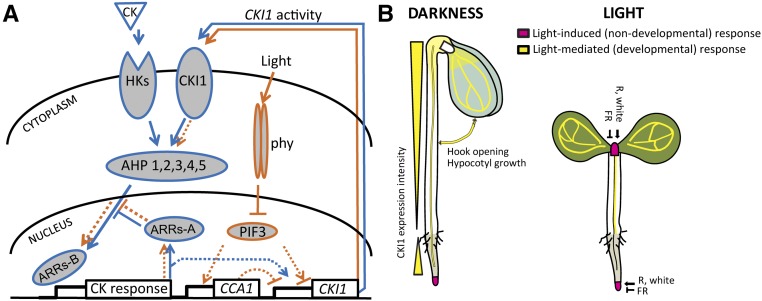Figure 5.
Light-dependent CKI1 expression controls cytokinin signaling. A, Model of interaction between light and cytokinin signaling via light-controlled CKI1. Light initiates autophosphorylation and nuclear transport of phytochromes that interact with PIF3 and mediate its light-dependent degradation. PIF3, which is able to act as both positive and negative regulator, binds to the promoter of transcriptional repressor CCA1 and controls its expression. Both PIF3 and CCA1 bind directly to the CKI1 promoter. Via an as-yet unknown mechanism that includes the action of phyA, and possibly other light receptors, light quality is translated into changes in the spatiotemporal specificity of CKI1 expression that include both up- and down-regulation of CKI1 activity. Besides that, CKI1 is also under cytokinin control. The resulting changes in the expression of constitutively active CKI1 modulate MSP activity at the level of ARRs-A expression and regulate cytokinin sensitivity. The exact position at which cytokinin signaling is negatively regulated via ARRs-A is still not clear. For the sake of simplicity, it is shown here as inhibiting the final step in the MSP signaling. The nuclear transport of AHPs and phytochromes is not part of the model as well. (Color code: blue, CK signaling pathway and response; orange, phytochrome signaling pathway and light-mediated response.) B, CKI1 expression is both under direct (nondevelopmental) and indirect (developmental) light control. Light-induced (direct, nondevelopmental) control over CKI1 is apparent in the SAM and LRC, where R light, potentially together with other components of the white light, positively regulates CKI1 via phyA and possibly other light receptors. In parallel, phyA mediates negative regulation of CKI1 by FR light in those tissues. Light-mediated (indirect, developmental) regulation of CKI1 associates with etiolation, leading to up-regulation of CKI1 in the vasculature of cotyledons, hypocotyl, and root transition zone. The spatiotemporal specificity of CKI1 expression in etiolated seedlings controls apical hook opening, hypocotyl elongation, and root growth.

